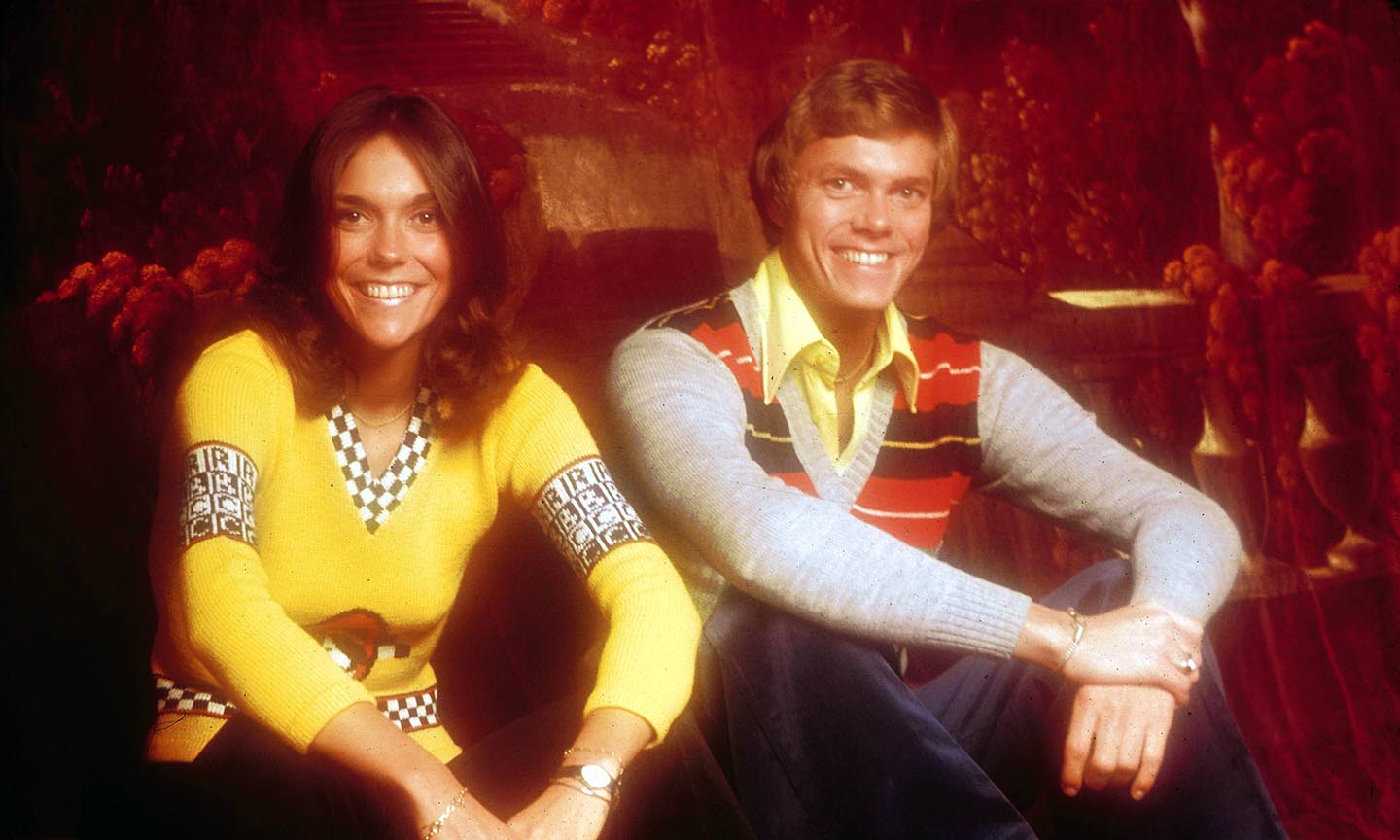Being hailed by a Watergate-shamed President Nixon as “young America at its best” is probably not the best thing for your street cred or reputation. For years thereafter, the music of Carpenters was pigeon-holed as AOR or soft-rock – tags that belied the duo’s boldness and creativity across a remarkable body of work. Those who listened closely, however, knew far better.
The Carpenter’s beginnings
Richard Carpenter gained a grounding in music through his father’s 78 RPM records, an eclectic collection that included Nat King Cole, Perry Como, and the Dixieland jazz of Red Nichols. In his late teens, he formed The Richard Carpenter Trio – a band in which he was pianist, sister Karen Carpenter played drums and friend Wes Jacobs was on upright bass and tuba – and the group won a prestigious battle of the bands, in June 1966, at the Hollywood Bowl. However, even Richard admitted that “our brand of rock-tuba was never going to catch on.”
When Richard and Karen moved away from instrumental jazz, they recorded a song he had written called “Looking For Love.” Despite the rawness of a track recorded in a garage lock-up in Los Angeles, the song had innovative elements, such as the phrasing of 16-year-old Karen’s vocals to the use of the flute. The demo tape impressed A&M Records co-founder Herb Alpert.
Richard was subsequently given carte blanche by Alpert to write songs for their 1969 debut album, Offering. The title track, a cover of The Beatles’ “Ticket To Ride” (which later gave the renamed album its title), was innovatively arranged as a slow ballad. It’s fitting that a gorgeous reworked version for the new orchestral album was recorded in August 2018 (with Richard as arranger and conductor) at the iconic Abbey Road Studios, where the Beatles first cut the track in 1965.
Though there were glimpses of real talent in Richard’s arrangements – including his use of the harpsichord in a baroque pop way – his promise was not really fulfilled until Carpenters released their second album, Close To You, which came out a year later. Richard said of the inspiration for the sound of this album that “Les Paul and Mary Ford probably had the biggest influence on me because of the overdubbed sound. Boy, did Karen and I take to the whole multi-track thing.”
(They Long to Be) Close To You
“(They Long to Be) Close To You” was a breakthrough song for the duo. It was a chart success – No. 1 on the Billboard charts for four weeks in 1970 – and earned a Grammy award for Best Contemporary Performance By A Duo, Group Or Chorus a year later, when Richard and Karen beat The Beatles and Simon & Garfunkel to the trophy.
Indeed, Carpenters deserve credit for their bold and progressive version of the song, composed by Burt Bacharach and Hal David. There had been previous versions by Dionne Warwick (and Bacharach himself), but even the original songwriter paid tribute to the free-flowing arrangement Richard Carpenter devised (using his Wurlitzer piano) to showcase Karen’s vocals.
Carpenters’ version was punchier than the original, with a swinging harmony and shorter pauses. Richard used a click track to synchronize the vocals (masterfully arranged into four-part harmonies tripled into 12 overdubbed vocal parts) and achieve the right effect. It took 47 takes just to get the extended “wahs” the way he wanted on the closing chorus. Trumpeter Chuck Findley had to repeatedly modify the trumpet part to get the sound waves to modulate in the way the producer wanted. “People were coming in during recording and saying, ‘We’ve never heard anything like this,’” Richard recalled.
Singer, producer, and record company owner Linda Perry said, “Richard is up there with Brian Wilson. He had the same kind of perfectionism and did such interesting things with the production and arrangement he put together.”
The song was an instant hit, and even Dionne Warwick noted, “Carpenters’ version was new enough, fresh enough that people did not associate it with me. It was a unique sound. They made the song their own.”
Richard Carpenter’s genius
Richard’s perfectionism carried over from the studio to their gigs. He would spend up to an hour before some concerts balancing the mics for instruments and vocals, a job usually left to the sound engineer.
As well as writing great songs, Richard had a knack for spotting winners. He first heard “We’ve Only Just Began” as the music on a television advert for Crockers Citizen Bank Of California and thought “this sounds like a hit record.” Richard rang songwriter Roger Nichols to ask whether the simple jingle had a bridge and a third verse. Nichols said that Richard’s genius for deft arrangements allowed the grace of Karen’s voice to turn lyrics “that were more greeting-card quality than Keats” into a hugely popular tune.
“Goodbye To Love” is another song that shows Carpenters’ enduring relevance. Richard had been watching TV when he saw the 1940 Basil Rathbone/Bing Crosby/Mary Martin movie Rhythm On The River, in which the song title is mentioned but never heard. His instincts were usually spot on; he recognized that the title alone was the building block for a future Top 10 hit, but it was his arrangements that created a sensation. Richard said, “I pictured something that was a little off the beaten path. I wanted two things that ordinarily don’t go together: a melodic fuzz guitar solo.”
The late guitarist Tony Peluso, who was a mainstay of Carpenters’ band for a decade, said Richard told him to “play the melody for five bars and then burn it up! Soar off into the stratosphere. He wanted an aggressive solo in the middle of this Doris Day easy-listening-style record. I thought, He can’t be serious. Inadvertently, Richard had broken new ground. No one had ever really mixed the elements of rock’n’roll and easy listening. Totally crazy but a great idea. From then on, it became very commonplace for a big power ballad to have a raging guitar solo.”
The reaction to this innovation was not universally positive. When Carpenters first heard the music on the radio, a DJ joked about them “doing a Jimi Hendrix song.” They also received mail from fans upset at a perceived musical heresy.
Carpenters’ ambition and experiments
Ever ambitious, however, Richard was always searching for new orchestration, whether it meant using woodwind instruments, strings, harp or tambourine, or even a blend of them all behind overdubbed harmonies. On “Make Believe It’s Your First Time,” he adapted what he called “tap dancing cheek” – the sound of Karen making three quick pulls on her cheek, with her thumb and forefinger – to produce a tap dancing sound. On “I’ll Never Fall In Love Again” (a song he heard Bette Midler singing on The Johnny Carson Show) he wanted a lusher sound and laid down a choral arrangement involving a 13-part 39-voice chord. This song earned Richard one of his five Grammy nominations as an arranger.
Carpenters had more hits throughout the 70s, and Richard continued to experiment. On the 1977 album Passage he got the most out of Karen’s voice by having a solitary soloist (oboe, flute, harmonica) as the counterpoint to her voice. That album also featured a cover of Canadian band Klaatu’s space anthem “Calling Occupants Of Interplanetary Craft (The Recognised Anthem Of World Contact Day),” a seven-minute blend of orchestra and guitar. As Peluso said, “It’s certainly not the kind of thing you expect from Carpenters. From a creative point of view, we all had a blast. Commercially? No, but I don’t think Richard cared.”
Another track on the album, “B’wana She No Home,” written by jazz singer Michael Franks, demonstrated an innovative use of conga and percussion, and has the unusual quality of seeing what happens when talented session musicians are let loose to strut their stuff.
Richard admitted he understood why he and his sister were dubbed as “goody four-shoes”, and he contested that “crappy” album covers, such as the cosy image on Close To You, did not help the group’s credibility.
Carpenters with The Royal Philharmonic Orchestra
Carpenter was a master of getting the best out of Karen’s exquisite voice, and on the A&M/UMe album Carpenters With The Royal Philharmonic Orchestra he took full advantage of the opportunity to set their classics on a larger scale, with an orchestra of nearly 80 top-class musicians, covering classics such as “Top Of The World” (1973), their US chart singles hits “We’ve Only Just Begun” (1970), “Superstar” (1971), “Rainy Days And Mondays” (1971), “Hurting Each Other” (1972) and “Yesterday Once More” (1973).
But, nearly 50 years on from their first record, the music of Carpenters now receives critical acclaim. Their exquisite multi-layered harmonies, novel arrangements, and creativity helped shape modern pop music.
Look beyond the coy images – and the later tragedy of Karen’s death, aged just 32 – and it’s possible to see that Carpenters were musical mavericks: not least for selling 150 million “soft vocal” records in an era when rock, punk, prog rock, and heavy metal were supposed to rule music.
Listen to the best of Carpenters on Apple Music and Spotify.



